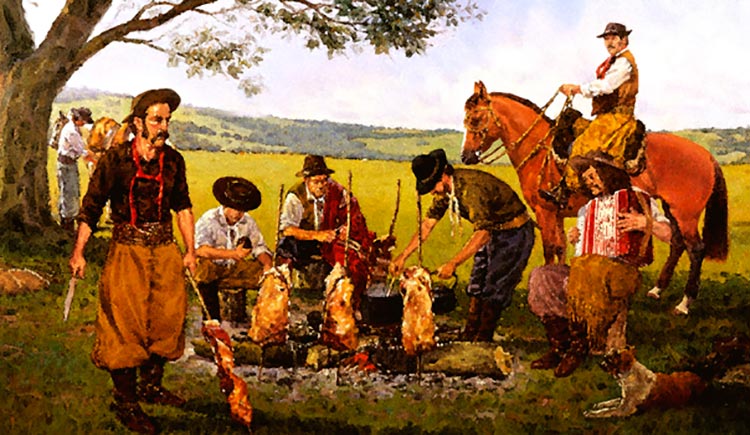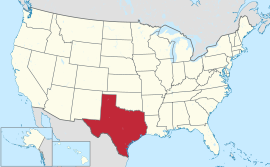In the short time that I’ve been here in Porto Alegre, many have compared the State of Texas with o Estado do Rio Grande do Sul in Brazil. At first, I wasn’t really sure what the deal was besides the obvious geographic correlation. Now that I have a better feel for the region, though, I can clearly see the parallels. Here is a blog post (in Portuguese) written from the perspective of a brasileira (Brazilian) who now lives in the the United States. Among other similarities, she writes about churrasco and barbecue, vaqueiros and cowboys, geography, German influence, and state pride.
CHURRASCO AND TEXAS BARBECUE
Churrasco is one of the first cultural phenomena that I experienced in Brazil. In fact, our first meal in Brazil was a welcoming churrasco. It’s a style of meat that originated in gaúcho (similar to the word cowboy, originally used to refer to a person with experience in livestock and farming) culture. The word “churrasco” seems to encapsulate the way that the meat is cooked, the way it is eaten, and the social gathering that is centered around it. A lot of houses in Rio Grande do Sul have a churrasco-style grill, and churrasqueria restaurants are everywhere. Similarly, Texas is known for it’s barbecue – and not only in the U.S. A fair number of Europeans also associated Texas with this style of cooking.


GEOGRAPHY
Rio Grande do Sul takes the “southernmost” prize in Brazil. The state reaches all the way down to almost the same latitude as Santiago, Chile. Similarly, Texas is the southernmost territory of the contiguous states aside from Florida. More importantly, both states share a border with the countries that lie south their respective countries: Uruguay for Brazil, and Mexico for United States. As a result, they share the influence of Spanish and all of the related cultural implications.


The parallel geography of these two states also led to parallels in their history and relationship with their mother countries. Like Texas, Rio Grande do Sul has somewhat of a separatist culture. In 1835, there was an uprising in Brazil that began in Rio Grande do Sul because of economic differences between it and the rest of the country. They held out until 1845, when the government granted the gaúchos some economic liberties and agreed to pay off their war debts. Texas declared itself independent from Mexico in 1836, becoming the Republic of Texas. This only lasted two years, however, until it was annexed as the 28th U.S. state.
STATE IDENTITY AND PRIDE
And because of their separatist histories (which, again, can be attributed to their geography), they maintain strong identities apart from their mother countries. Of course they both remain within and part of their respective countries, but they have distinct cultures.
Many people joke (some are serious 🙁 ) about Texas being its own country. I haven’t heard anyone even play with that type of idea here in Rio Grande do Sul. However, there is a very present gaúcho culture. For example, there is a guy from São Paulo at Rockhead who has mentioned words and traditions specific to “you gaúchos” when speaking with people from the south.
OTHER RIO GRANDE DO SUL TREASURES
Putting the Texas comparison aside, Rio Grande do Sul has some interesting treasures specific to the area.
X

Oh the good ‘ole X. When we first got here, people said we had to try the “sheece” because it was typical of the region and a delicious (though fairly unhealthy) dish. When we went with a friend to a lancheria (“snack bar”), almost the whole menu started with “X”. There was “X Bacon,” “X Burger,” “X Frango,” “X Coração.” After some confusion, our friend explained that the “X” in Portuguese is pronounced “sheece.” Ahhhh okay, got it… not quite. I’m not sure why, but I thought that “X” was just the name that they gave to the dish for such and such reason. I went about a month like that until Chips pointed out the “cheese”-x-“sheece” relationship. OHHHHHH. So it came from CHEESE burger.
The X is strongly associated with Porto Alegre. The most Porto Alegrense order, though, would be a X Coração (literally “cheese heart”). The “heart” comes from the fifteen-ish quarter-sized chicken hearts that they put in the cheeseburger. Chips has hosted a lot of foreigners in Porto Alegre, most of which find the chicken heart idea revolting. Even some of the guys from other regions in Brazil think it’s disgusting.
FRUKI.
Fruki is a beverage company that started as a small organization in the 1920s in Rio Grande do Sul. Today it’s an empire; it claims a large portion of the water and refri (soft drink, short for refrigerante) markets in the region. I was first introduced to it through their most famous drink, a guaraná refri. Guaraná is a plant from the Amazon basin as well as a type of refri that is made from the plant. Fruki is also known for using recycled beer bottles as containers for their product.

CHIMARRÃO
Chimarrão isn’t just a drink. It’s a culture — people walk around in the mall and at parks with their chimarrão and hot water thermos in hand. When we were at a get-together with Allie’s coworkers, people were passing around chimarrão. They would pour hot water over the erva-mate, drink it up, and then they pass it on for the next person to do likewise. Chimarrão is one of the most visible aspects of gaúcho culture. People are proud of the tradition, and make an effort to keep it alive. I enjoy it a lot – I will be bringing my cuia and bomba back to the U.S. 🙂

BUFFETS
All-you-can-eat buffets are quite common. Most of the places around campus (which are independent restaurants) where I eat with my colleagues are buffets. They are not as widespread in other regions of Brazil. In São Paulo, for example, the open-buffet style is common, but you pay according to the weight of your food.
Their regularity poses a strange situation for those not accustomed to buffets. I, for one, felt strange going to buffets every day because I (unfortunately) subscribe to the American idea of “more, more, more”. There were many times where I definitely consumed too much – simply because it’s available and it seems like a grand opportunity. It made me realize how twisted our concept of food (and material, in general) can be.
OTHER GOOD BRAZILIAN FOODS
- Paçoca de amendoim – basically dried peanut butter
- Feijoada – beef and pork strew
- Farofa – toasted cassava flour, usually with meat and/or stew
- Mandioca – cassava, consumed in various forms
Rio Grande do Sul has grown on me quite a bit; I think I will always identify with the gaúcho culture. In the future, when I reflect on my time here in Brazil, I know there will be a strong association to this region. Thus far, my experience in Brazil has been defined by the people and traditions in Porto Alegre.
Fun facts and random notes:
- Smoking is very common at Casa do Campus. I am constantly surprised by how many people smoke, and how often they do it. It doesn’t surprise me in the older generations, but college-aged kids are very aware of the consequences and choose to do so anyway.
- Chips says a lot of Brazilians would like to get out of their country, and most would say that they want to go to the U.S. Chips, although not in the typical situation (as he owns a business and works in tech), has been trying to find a way to live in the U.S.
- We went the first month using only fabric softener in our laundry. Evidently “amaciante” means softener and not detergent. Our clothes may not have been the cleanest, but at least they were smelling good.
- Allie’s comments, cont… on the subject of Texas, she compared Chicago to “people down in Whitey McWhitersville” in some parts of Texas.

Iris Hamilton
August 3, 2017 at 1:18 pmVery interesting blog. I am anxious to see you.